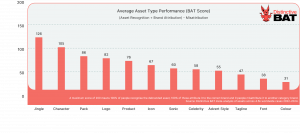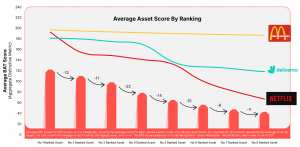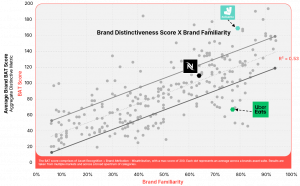
New Research Breaks Down The DNA Of Distinctive Brands
New research by Distinctive BAT highlights the key factors that drive distinctiveness in brands.
Since the publication of “How Brands Grow” by Byron Sharp and the Ehrenberg Bass Institute and the follow-up “Building Distinctive Brand Assets” by Jenni Romaniak, distinctiveness has become a central focus for marketers in their thinking, planning, and action. Distinctiveness plays a major role in helping brands to be more mentally and physically available at key times and to stand out at the point of purchase. As a result, it has become a major consideration for most marketers and a key tenet of most organisations' strategic thinking in relation to brand building.
“We’ve tested thousands of distinctive brand assets across hundreds of brands in recent years, and there are several common factors that come to the fore for high-achieving brands,” says Cathal Gillen, Co-Founder and Head of Strategy at Distinctive BAT. “By understanding the composition of distinctive brands and how DBAs become noteworthy, marketing teams can plan for distinctiveness success. While some brands use all the building blocks, others lean on some more than others to great success. Some require discipline, others require creativity, and all require a plan.”
“The first factor is Prioritisation. It is critical to identify your distinctive assets and prioritise which will take the lead. Some of the most distinctive brands focus on just one or a few assets and prioritise them above all else. While a wide range of assets can be beneficial, it can also lead to a lack of focus and dilution of the use and reach of assets across touchpoints. While it varies by brand, we often see a drop-off in asset performance around the 3rd or 4th highest scoring asset, especially when you move away from the iconic brands of this world. After this, many brands are spreading themselves too thin. Balance is key; focus on embedding one or two key assets first and step-loading them over time.”
Secondly, he believes Ruthless Consistency is required. “The goal is to maximise exposure of the same assets repeatedly, driven by the level of ruthlessness and consistency across touchpoints from campaign to campaign. Once you have identified which asset(s) take the lead, you must adopt a single-minded approach to how and where your assets are used. Only when you get comments internally about how sick people are of seeing the same assets used over and over, that’s when you know you are on the right path”.
Based on the research conducted by Distinctive BAT across numerous categories, Cathal has also seen the key role creativity plays. “Prioritisation and consistency raise the floor; creativity raises the ceiling. It is a massive lever a brand can pull to its advantage. When it comes to distinctive assets, creativity can take many forms. Firstly, during asset development, deviation from the norm is often at the centre of a strong distinctive asset. If an asset inherently stands out, it already has a significant advantage. Secondly, creativity plays a commanding role in how the distinctive asset is used in advertising.”
The next factor is Reach & Frequency. “These two related variables contribute greatly to DBA success, with brand size heavily correlated. Generally, larger brands have bigger media budgets and a greater scale of owned touchpoints—driven by physical availability and product in hand—the easier it becomes for a brand to embed distinctive assets.
We see this play out in our global database, with 2 in 3 brands having a DBA suite as powerful as expected based on their brand size (with familiarity used as a proxy for size). However, for the other 1 in 3 brands, we found that their assets either overperformed or underperformed relative to expectations for a brand of their size. Deliveroo, for instance, is an example of a brand that punches above its weight (in the U.K.), while Uber Eats underperforms with the brand lacking distinctiveness. All other marketing activities held constant, this puts Uber Eats at a big disadvantage compared to their more distinctive rivals in Deliveroo and Just Eat. While activation strategies will vary depending on brand size and category, all brands should aim to ensure that owned, earned, and paid channels are maximised to embed assets.” Cathal points out.
Finally, Asset Type Usage is key, as Matthew Ovington, Co-Founder and Head of Research at Distinctive BAT, emphasises. “The asset type can vary drastically in performance, with some consistently outperforming others. Character assets are often standout performers. Our ability to remember faces—especially animals—gives characters a distinct advantage. Jingles also outperform other asset types more often than not; they are incredibly hard-working, sticky devices, and jingles are the top-performing asset types in our research. Other asset types, like taglines, often play a role more related to meaning and differentiation than distinctiveness. While there are some common trends, asset performance also depends on the category and brand. For example, some categories provide for products or packs in the hands of consumers, allowing them to be embedded much more easily. Some brands have limited AV or audio advertising in their media plan, making leading with a sonic asset or jingle pointless. Clarity on the roles and strengths of different asset types for your brand and category is important in planning for distinctiveness success.”
In addition to outlining the key components of distinctive brands, the research provides practical steps required for driving distinctiveness. “We’ve collaborated with many brands and seen firsthand how the best marketing and insights teams move the distinctiveness dial” Cathal adds, “There are practical and actionable steps that teams can take, regardless of where they are on their distinctiveness journey, and we hope our research will help them propel their brands forward.”
The research guide is available to download here on the Distinctive BAT website.
Cathal Gillen
Distinctive BAT
cathal@distinctivebat.com
Visit us on social media:
LinkedIn
Distribution channels: Media, Advertising & PR
Legal Disclaimer:
EIN Presswire provides this news content "as is" without warranty of any kind. We do not accept any responsibility or liability for the accuracy, content, images, videos, licenses, completeness, legality, or reliability of the information contained in this article. If you have any complaints or copyright issues related to this article, kindly contact the author above.
Submit your press release


